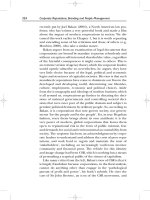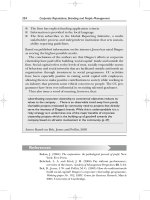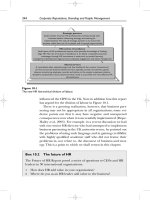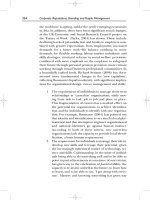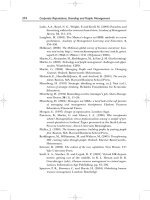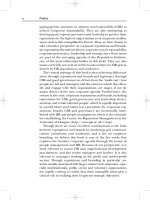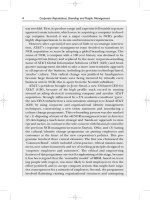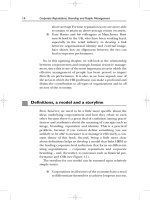Tài liệu Corporate Reputations, Branding and People Management 6 ppt
Bạn đang xem bản rút gọn của tài liệu. Xem và tải ngay bản đầy đủ của tài liệu tại đây (122.64 KB, 10 trang )
understanding of the linkages between HR and marketing in
the brand management and reputation building processes (see
also Sparrow et al., 2004). Naturally enough, given their back-
grounds, education and interests, marketers have been good at
using the language of branding and communications to shed
new light on people management, and have produced prac-
tical tools for assisting HR professionals to apply the language of
branding to people management problems. However, they
have said little about the complex nature of employee identifi-
cation with brands and organizations, other than at a general
level and usually in highly prescriptive manner. As befits busi-
ness disciplines that are essentially normative, marketing and
communications sometimes fail to deal with the realities or
causes of much of organizational life, such as cynical or apathetic
employee attitudes to customer service, unethical products
and practices, disenchanted managers and the competing pro-
fessional identities of many knowledge workers that have little
connection with advancing ideas of corporateness.
So, for HR professionals, the rising star of corporateness
marks a watershed and a real opportunity to become corpor-
ate, as well as business, partners. However, it also brings signifi-
cant challenges for the role of the HR function, as well as the
capability of HR professionals to ‘round themselves out’, lead
and deliver people strategies that support corporate reputa-
tions and brand, CSR and good governance.
References
Aaker, D. A. (2004) Leveraging the corporate brand, California
Management Review, 46 (3), 6–18.
Albert, S. and Whetten, D. (1985) Organizational identity, in
L. L. Cummings and B. M. Staw (eds), Research in organizational
behaviour 7. Greenwich, CT: JAI Press, pp. 263–295.
Alessandri, S. W. and Allessandri, T. (2004) Promoting and protect-
ing corporate identity: the importance of organizational and
industrial context, Corporate Reputation Review, 7, 252–268.
Bakan, J. (2004) The corporation: the pathological pursuit of profit.
New York: Free Press.
Balmer, J. T. and Greyser, S. A. (2003) Revealing the corporation: perspec-
tives on identity, image, reputation, corporate branding and corporate-
level marketing. London: Routledge.
34 Corporate Reputations, Branding and People Management
Barrow, S. and Mosley, R. (2005) The Employer Brand
®
: bringing the best
of brand management to people at work. London: Wiley.
Berthon, P., Hulbert, J. M. and Pitt, L. F. (1999) Brand management
prognostications, Sloan Management Review, 40 (Winter), 53–65.
Boxall, P. and Purcell, J. (2003) Strategy and human resource manage-
ment. London: Palgrave Macmillan.
CIPD (2004) Business partnering: a new direction for HR. Wimbledon:
CIPD.
Clarke, T. (ed.) (2004) Theories of corporate governance: the philosophical
foundations of corporate governance. London: Routledge.
Conway, N. and Briner, R. B. (2005) Understanding psychological con-
tracts at work: a critical evaluation of theory and research. Oxford:
Oxford University Press.
Davies, G. with Chun, R., Da Silva, R. V. and Roper, S. (2003) Corporate
reputation and competitiveness. London: Routledge.
Davies, G., Chun, R., Da Silva, R. V. and Roper, S. (2004) A corporate
character scale to assess employee and customer views of organ-
ization reputation, Corporate Reputation Review, 7, 125–146.
de Chernatony, L. (2001) From brand vision to brand evaluation.
Oxford: Butterworth–Heinemann.
Deephouse, D. L. and Carter, S. M. (2005) An examination of differ-
ences between organizational legitimacy and reputation, Journal
of Management Studies, 42, 329–360.
Dowling, G. R. (2001) Creating corporate reputations: identity, image and
performance. New York: Oxford University Press.
Dowling, G. R. (2004) Corporate reputations: should you compete
on yours? California Management Review, 46 (3), 19–36.
Dunsford, B. B., Snell, S. A. and Wright, P. M. (2001) Human resources
and the resource based view of the firm. CAHRS Working Paper
01-03, School of Industrial and Labor Relations, Ithaca, NY:
Cornell University Press.
The Economist (2004) Selling the flag, The Economist, 26 February.
The Economist (2006) St Lawrence of Google, The Economist, 14 January.
Florida, R. (2005) The flight of the creative class. New York: Harper-
Collins.
Fombrun, C. J. and Van Riel, C. B. M. (2003) Fame and fortune: how
successful companies build winning reputations. Upper Saddle
River, NJ: Financial Times/Prentice Hall.
Gelade, G. A. and Young, S. (2005) Test of a service profit chain
model in the retail banking sector, Journal of Occupational and
Organizational Psychology, 78, 1–22.
Goiia, D. A., Shultz, M. and Corley, K. G. (2000) Organizational iden-
tity, image and adaptive instability, Academy of Management
Review, 25 (1), 63–81.
Chapter 1 The importance of the corporate agenda and its links with HRM 35
Golden-Biddle, K. and Rao, H. (1997) Breaches in the boardroom:
identity and conflicts of commitment in a nonprofit organiza-
tion, Organizational Science, 8, 593–611.
Greenwald, B. and Kahn, J. (2005) Competition demystified. New York:
Portfolio/Penguin.
Hagel IIIrd, J. and Seely Brown, J. (2005) The only sustainable edge: why
business strategy depends on productive friction and dynamic special-
ization. Boston, MA: Harvard Business School Press.
Haig, M. (2003) Brand failures: the truth about the 100 biggest branding
mistakes of all time. London: Kogan-Page.
Haig, M. (2004) Brand royalty: how the world’s top 100 brands thrive and
survive. London: Kogan-Page.
Harris, F. and de Chernatony, L. (2001) Corporate branding and cor-
porate brand performance, European Marketing Journal, 35 (3/4),
441–456.
Harter, J. M., Schmidt, F. and Hayes, T. L. (2002) Business unit level
relationships between employee satisfaction/engagement and
business outcomes: a meta-analysis, Journal of Applied Psychology,
87, 268–279.
Hatch, M. J. and Schultz, M. (2001) Are the strategic starts aligned
for your corporate brand?, Harvard Business Review, Jan–Feb,
pp. 129–134.
Hill and Knowlton (2004) Global corporate reputation watch survey.
(28 February 2006).
Human Resource Management Journal (2005) Special issue: The link
between HRM and performance, Human Resource Management
Journal, 15 (4).
Jackson, K. T. (2004) Building reputation capital: strategies for integrity
and fair play that improve the bottom line. Oxford: Oxford University
Press.
Joyce, W., Nohria, N. and Robertson, B. (2003) What really works: the
4+2 formula for sustained business success. Boston, MA: Harvard
Business School Press.
Kaplan, R. and Norton, D. (2001) The strategy-focused organization.
Boston, MA: Harvard Business School Press.
Kay, J. (2004) The truth about markets: why some nations are rich but most
remain poor. London: Penguin Books.
Kellerman, B. (2004) Bad leadership: what it is, how it happens and why
it matters. Boston, MA: Harvard Business School Press.
Klein, N. (2000) No logo: no space, no choice, no jobs. New York: Picador.
Leseure, M. J., Bauer, J., Birdi, K., Neely, A. and Denyer, D. (2004)
Adoption of promising practices: a systematic review of the
evidence, International Journal of Management Reviews, 5/6, 169–190.
36 Corporate Reputations, Branding and People Management
Martin, G. (2006) Managing people and organizations in changing con-
texts. Oxford: Butterworth–Heinemann.
Martin, G. and Hetrick, S. (forthcoming) Corporate reputation,
branding and people management: the case of Finco.
Martin, G. and Riddell, T. (1996) ‘The wee outfit that decked IBM’:
manufacturing : strategic change in the ‘Cash’, Strategic Change,
5 (1), 3–25.
Martin, G. and Beaumont, P. B. (2003) Branding and people manage-
ment: what’s in a name? Wimbledon: CIPD.
Martin, G., Beaumont, P. B. and Pate, J. M. (2003) A process model of
strategic change and some case study evidence, in W. Cooke
(ed.), Multinational companies and transnational workplace issues.
Westport, CT: Quorum Press.
Martin, G., Beaumont, P. B., Doig, R. M. and Pate, J. M. (2005)
Branding: a new discourse for HR?, European Management Journal,
23 (1), 76–88.
Pate, J., Martin, G. and Staines, H. (2000) The new psychological con-
tract, cynicism and organizational change: a theoretical framework
and case study evidence, Journal of Strategic Change, 9 (1), 481–493.
Pfeffer, J. (2005) Creating a performance culture. Presentation at
University of Strathclyde, 23 September.
Pierce, J. L., Kostova, T. and Dirks, K. T. (2001) Towards a theory of
psychological ownership in organizations, Academy of Manage-
ment Review, 26, 298–310.
Rindova, V. P., Pollock, T. G. and Hayward, M. L. A. (2006) Celebrity
firms: the social construction of market popularity, Academy of
Management Review, 31: 50–71.
Roberts, J. (2004) The modern firm: organizational design for performance
and growth. New York: Oxford University Press.
Roberts, P. W. and Dowling, G. R. (2002) Corporate reputation and
sustained superior financial performance. Strategic Management
Journal, 23, 1077–1093.
Robinson, D., Perryman, S. and Hayday, S. (2004) The drivers of
employee engagement. Institute of Employment Studies, Report
No. 404. Brighton: IES.
Schultz, M. and de Chernatony, L. (2002) Introduction: The chal-
lenges of corporate branding, Corporate Reputation Review, 5
(2/3), 105–112.
Sjovall, A. M. and Talk, Andrew C. (2004) From actions to impres-
sions: cognitive attribution theory and the formation of corpor-
ate reputation, Corporate Reputation Review, 13, 269–281.
Sparrow, P. R. and Cooper, C. L. (2003) The new employment relation-
ship. Oxford: Butterworth–Heinemann.
Chapter 1 The importance of the corporate agenda and its links with HRM 37
38 Corporate Reputations, Branding and People Management
Sparrow, P. R., Brewster, C. and Harris, H. (2004) Globalizing human
resource management. London: Routledge.
Ulrich, D. and Brockbank, W. (2005) The HR value proposition. Boston,
MA: Harvard Business School Press.
Van Riel, C. B. (2003) The management of corporate communica-
tions, in J. M. T. Balmer and S. A. Geyser (eds), Revealing the cor-
poration: perspectives on identity, image, reputation, corporate branding
and corporate-level marketing. London: Routledge.
Whetten, D. and Mackey, A. (2002) A social actor conception of organ-
izational identity and its implications for the study of organiza-
tional reputations, Business and Society, 41, 393–414.
